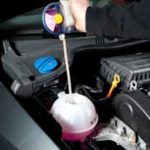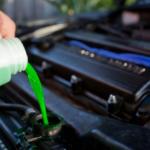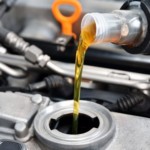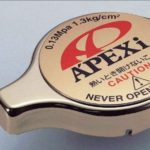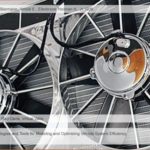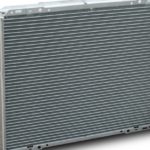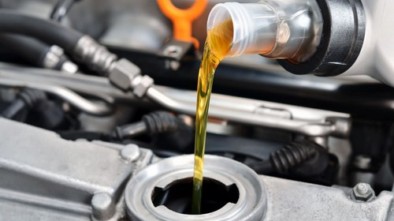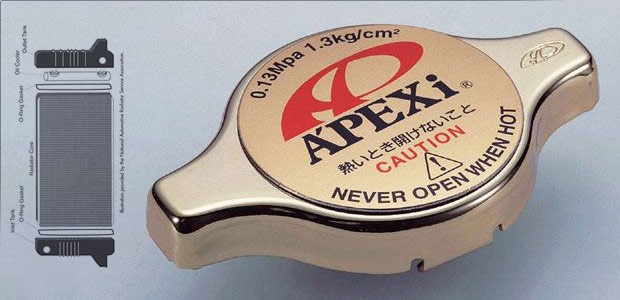Antifreeze - Part 2
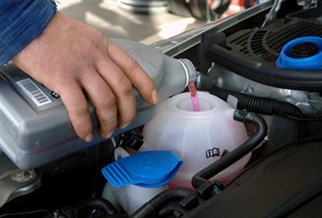
Antifreeze
Engine coolant - antifreeze
Antifreeze is often only seen as a frost protection agent, although corrosion behavior is of far greater importance because in cooling system ideal conditions for corrosion development rule. If the corrosion inhibitors are not sufficiently represented or are not mutually compatible, the cooling system and the motor itself may be damaged. The chemical composition is crucial for the quality of the refrigerant. The basic structure of the refrigerant is:
BASE FLUID + ADDITIVES + WATER
Base fluid - monoethylene glycol (MEG), or less frequently propylene glycol
Additives - corrosion, cavitation and deposition inhibitor, antifoam, stabilizer and buffer
Water - must be distilled or demineralized, and the pH value at 200C = 7-8, in the new types, due to the absence of silicates and phosphates, hard water can also be used.
The undiluted refrigerant (concentrate) should contain at least 90% MEG, at most 4% water, and the other components are additives. The coolant must meet a number of conflicting requirements such as: low freezing temperature, high boiling point, low volume expansion coefficient, minimum viscosity, non-flammability, not to foam and cause changes in structural materials, good heat conductivity, high specific heat, etc.
The basic requirements for refrigerator protection are:
Corrosion prevention caused by hot water. At high temperatures, water reacts with aluminum to produce hydrogen, which destroys the metal structure.
Prevention of surface corrosion. There is no ideally smooth surface, and the degree of roughness depends on the intensity of the corrosive activity of the aggressive materials.
Contact Corrosion Prevention. Particles of different metals (Fe, Al, Cu) can be found in the coolant during use as a consequence of damage to individual parts. If a metal particle settles on the aluminum surface, the so-called local element - there is a potential difference that results in the so-called. contact corrosion - decomposition of aluminum and formation of small holes.
Corrosion prevention in cracks. In cracks and gaps where the refrigerant is unable to circulate, the concentration of corrosive substances is increased and corrosion is accelerated.
Prevention of cavitation. Vapor bubbles can form in the water pump and in the cylinder head due to a short-term pressure drop in the system, which then burst when the pressure rises again. As a result, there is an impact on the metal surface, which takes away the material and creates a characteristic perforated surface, and even complete "biting" can occur.
Prevention of limestone deposition. If hard water is used, at temperatures higher than 600C stands outlimescale - limestone and other minerals.
Avoiding foaming. The foam reduces the efficiency of the coolant and results in partial overheating.
Compatibility with materials. The coolant comes in contact with various materials (metals, seals and hoses) without being aggressive.
An internal combustion engine that drives almost all cars when combining air / fuel mixtures converts thermal energy into mechanical energy to drive the wheels. One part of the heat energy is converted into operation, the other part goes with the combustion gases and the remaining part of the heat must be removed from the engine via a cooling system to prevent overheating and damage to the engine parts. The cooling system maintains the engine at the optimum temperature which is of great importance for the normal and correct operation of the engine. Without an efficient cooling system, the engine would be destroyed in minutes by its own heat.
Table 1: Ratio of antifreeze and water at the appropriate freezing temperature
|
% Concentration
|
Freezing temperature, 0C
|
|
|
Concentrated coolant
|
Water
|
|
|
10
|
90
|
- 4,5
|
|
20
|
80
|
- 10
|
|
30
|
70
|
- 16
|
|
35
|
65
|
- 22
|
|
40
|
60
|
- 27
|
|
50
|
50
|
- 38
|
|
60
|
40
|
- 52
|
|
70
|
30
|
- 70
|
|
90
|
10
|
- 32
|
|
100
|
-
|
-23
|
Monoethylene glycol is toxic and has a sweet taste (30ml kills a child and 100ml an adult). To protect consumers from potential oral use, manufacturers add components that give a bitter taste and are required to indicate on the label: Poison! That's why lately it's been switching to less-toxic propylene glycol. Propylene glycol is necessarily used in refrigeration systems in the food industry where there is a risk of food contact.
Additives are mandatory additions to coolants. Pure monoethylene glycol corrodes ferrous and non-ferrous metals. Mono-ethylene glycol is added to a multifunctional additive package that is designed to prevent the appearance of foam due to the penetration of air or exhaust gases, the rust and corrosion that can result from the action of glycol-degrading products, which are acidic. The task of the additives is to maintain the coolant pH between 7 and 11 during use.
Due to the wear of the additive during use, coolant manufacturers recommend replacing it after two years for conventional ones, three years for hybrid ones and five years for organic ones.
The following are appearing on the market:
- Conventional coolants containing silica-based corrosion inhibitors.
- Hybrid coolants containing silicates and a mixture of various organic acids.
- Organic coolants do not contain phosphates, silicates, nitrites and nitrates. Corrosion inhibitors are a mixture of organic acids. In addition to frost protection, they provide long-term protection against all forms of corrosion and cavitation in cast iron, aluminum or a combination of the two metals, as well as in aluminum or copper alloy cooling systems. Primarily recommended for new generation engines.
Concentrated coolant and water are usually mixed in a ratio of 1: 1. The water must be clean and soft. The pH value of the refrigerant water must be in the range of 7 to 8 to 20oC.
Mixing (topping up) refrigerants from different manufacturers is only allowed if they are monoethylene glycol based and have the same chemical composition. However, it is recommended that antifreeze from different manufacturers and different types should not be mixed. If conventional type of antifreeze containing silicates as well as corrosion inhibitors are mixed with organic type antifreeze containing silicates, phosphates, nitrites and nitrates (corrosion inhibitor of this type of antifreeze is a mixture of organic acids), aluminum corrosion can result.
Coolants should not contain nitrites as corrosion inhibitors. Nitrites are transformed into carcinogenic nitrosoamines during use. However, as some antifreeze may contain nitrites, skin contact should be avoided during replacement and should not be thrown into drains or rivers.
When using antifreeze, keep in mind that:
- without corrosion inhibitors or with insufficient inhibitors corrosion and coolant leakage occur and foam appears in the refrigeration system. Glycerin-based antifreeze rapidly loses its anti-freeze properties,
- concentrated antifreeze has reduced frost protection (only up to -17oC) and causes the engine to overheat,
- too diluted antifreeze with water has a low freezing point and causes corrosion in the refrigerator,
- the use of antifreeze for longer than the recommended time limit lowers the freezing point and leads to corrosion in the refrigerator,
- mixed incompatible antifreezes lead to gelatinous deposits in the cooling system, engine overheating and corrosion in the refrigerator
Antifreeze must meet the quality requirements of the defined:
- National Standards (BS, AFNOR, SRPS,…)
- International Branch and Military Standards (ASTM, SAE, MIL, DEF), which determine the minimum quality of antifreeze and the minimum change period
- OEM specifications of motor vehicle manufacturers (VW, PSI, RENAULT, GM, MERCEDES, VOLVO, MAN and others). Different vehicle manufacturers condition different antifreeze quality depending on engine design and cooling system.
Table 2: Specifications of known motor vehicle manufacturers
|
Vehicle manufacturer
|
Specification
|
|
Audi, Seat, VW, Skoda, Porsche
|
TL - VW 774 C = (G11) - without nitrite
TL - VW 774 D = (G12) - without silicate
|
|
BMW N 600 69.0 - Nitrite free
|
|
|
Mercedes Benz
|
Sheet 325.0 (nitrite free); Sheet 325.2 (conventional); Sheet 325.3 (without silicate)
|
|
Ford
|
SSM - 97 B 9102 - A - conventional / WSS-M97B44-D- silicate free
|
|
Fiat, Iveco
|
55523/1 - conventional
|
|
Opel / GM
|
B 040 0240 - nitrite free / B040 1065 - silicate free
|
|
Mazda
|
TI 13/82 - conventional; MEZ 121C
|
|
Renault
|
Type C - nitrite free / Type D - silicate free
|
|
Volvo
|
128 6083/002 - nitrite free
|
|
John Deere
|
JDM H5 - conventional
|
|
Toyota
|
TSK 26016 - silicate free
|
|
MAN
|
MAN 324N (conventional) 324 NF (nitrite free) 324 SNF (silicate free)
|
|
Scania
|
O - 891027 GT EN - conventional / TB1451 - nitrite free / TI 02 - silicate free
|
|
Deutz / MWM
|
0199-99-1115
|
|
Honda
|
HES D 2009-75
|
|
Komatsu
|
07.892 (2001)
|
- IAT - Traditional antifreeze. Replacement period 1 to 2 years
- HOAT - Long Life Hybrid antifreeze - organic corrosion inhibitors with Silicates (SOAT) / or nitrites (NOAT). Replacement period 3 years.
- OAT - Long Life Organic Antifreeze. Replacement period 5 years.
Traditional Antifreeze (IAT) is based on monoethylene glycol and inhibitors to protect motor vehicle cooling systems from freezing and corrosion. Free of amines, phosphates and nitrites. The corrosion inhibitor package contains silicates. Meets international standards: BS 6580, AFNOR NF R15-601, SAE J1034, ONORM V 5123: 2009, ASTM D3306-08a. The replacement period for this type of antifreeze is two years.
Hybrid Antifreeze (HOAT) is based on monoethylene glycol quality G11. It contains a hybrid package of inhibitors based on silicates and salts of organic acids. It does not contain nitrites, amines or phosphates. Meets the following quality standards: ASTM D 3306, ASTM D 4985, SAE J 1034, AFNOR NF R 15-601, BS 6580: 1992 and motor vehicle manufacturer's specifications: BMW N 600 69.0, Daimler Chrysler 325.0 / 325.2, Deutz H-LV 0161 0188, MAN 324-NF, MTU MTL 5048, Opel / General Motors B 040 0240, Porsche for 924, 944, 968, 928, Saab 6901599, VW / Audi / Seat / Škoda TL 774-C. The replacement period of this type of antifreeze is three years.
Organic Antifreeze (OAT) is an organic liquid for protecting motor vehicle cooling systems from freezing and corrosion, based on monoethylene glycol quality G12 +. It does not contain amines, phosphates, nitrites and silicates. The corrosion inhibitor package is based on organic acids. Meets the following quality standards: ASTM D3306 & D4656 / 4985, JASO M 325, RENAULT 41 01 001, BS 6580, John Deere H24B1 & C1, GM / OPEL 1940656 / 6277M, VolvoNATO S-759, PSA B715110 and motor vehicle manufacturer's specifications: VW G-12 engines spec: TL-774-D, MB 325.3, MAN 324-SNF, MTU MTL 5048, PORSCHE TL-774-D, FORD WSS-M79B44-D. The replacement period for this type of antifreeze is five years.
Concentrated antifreeze, before use, should be diluted with water with the following characteristics:
- Water hardness: 0-20 ° dH (0 mmol / l)
- Chloride content: max. 100 ppm
- Sulfate content: max. 100 ppm
If the water analysis values are greater than the permitted limits, the water should be properly prepared, e.g. by adding soft, distilled or demineralized water, i. water without salt. This can reduce the excess sulfate and chloride content.
Plumbing water should be avoided as it forms a scale that settles, clogs the cooler and reduces engine cooling. It can only be used as a last resort because it reduces the quality of antifreeze.
The antifreeze can be stored in original airtight enclosed barrels at temperatures up to 30 ° C for at least 3 years. To prevent corrosion, the product should not be stored in galvanized vessels.
Source: www.nisotec.eu
Recommendation of similar texts:

Hi there, I am Mladen and I am an auto enthusiast. I started this blog years ago to help like minded people share information about latest cars, car servicing ideas, used car info, exotic cars, and auto technology. You will find helpful articles and videos on a wide variety of cars - Audi, Mercedes, Toyota, Porsche, Volvo, BMW and much more. Ping us if you have anything cool to share on latest cars or on how to make older cars more efficient, or just want to say hi!

